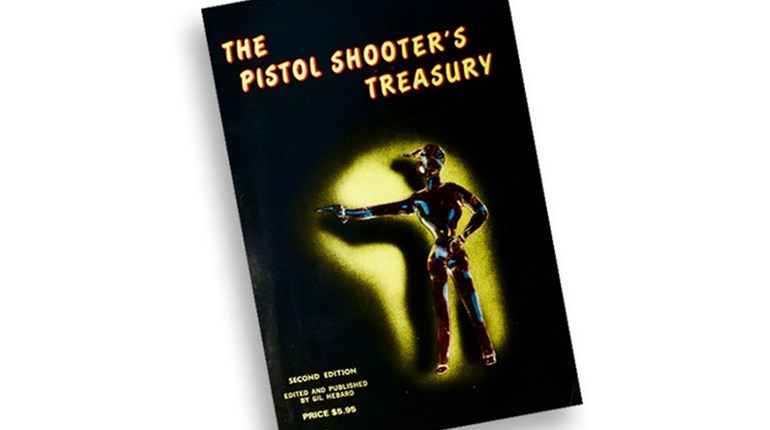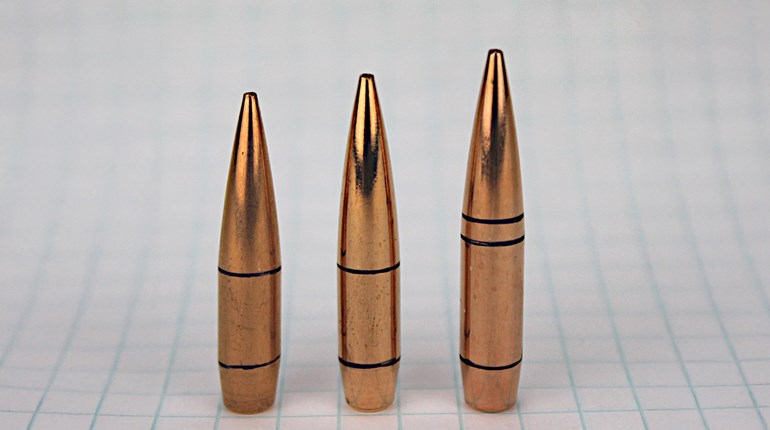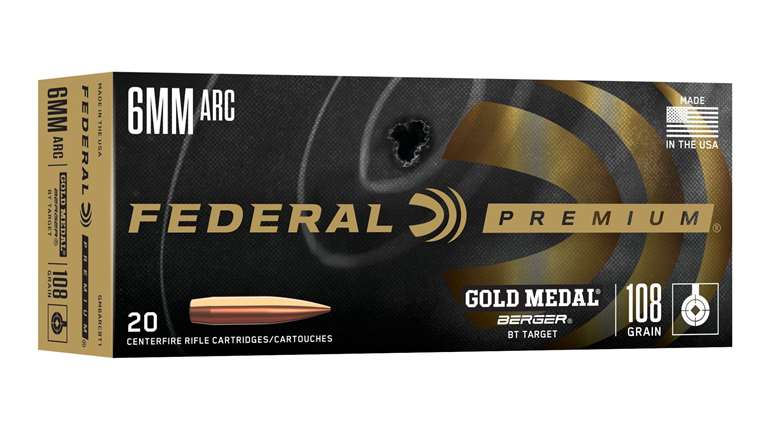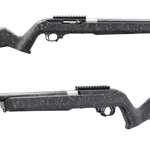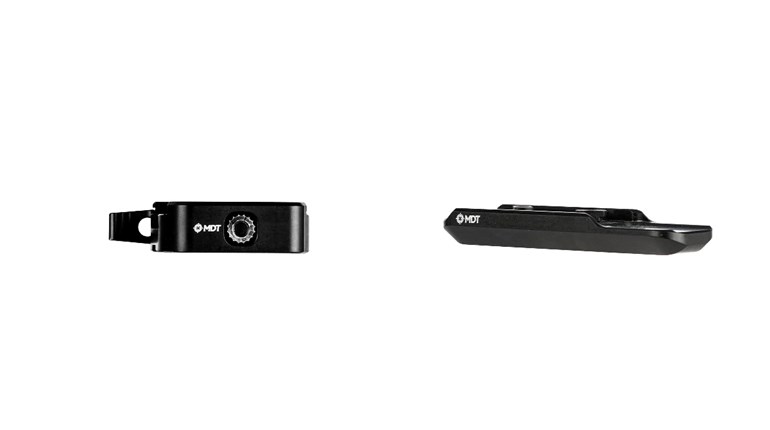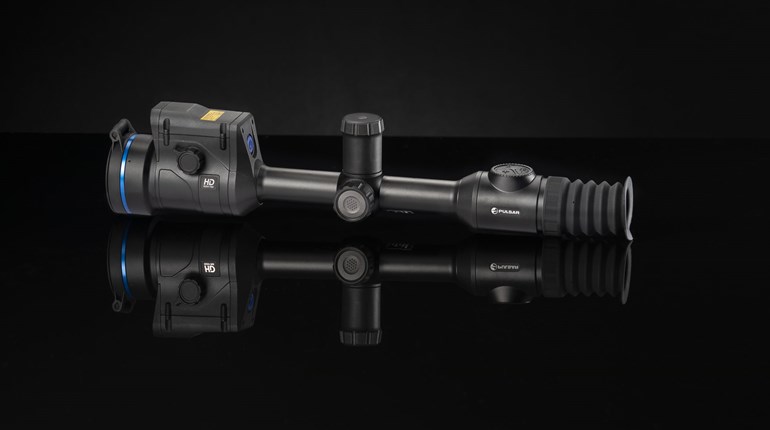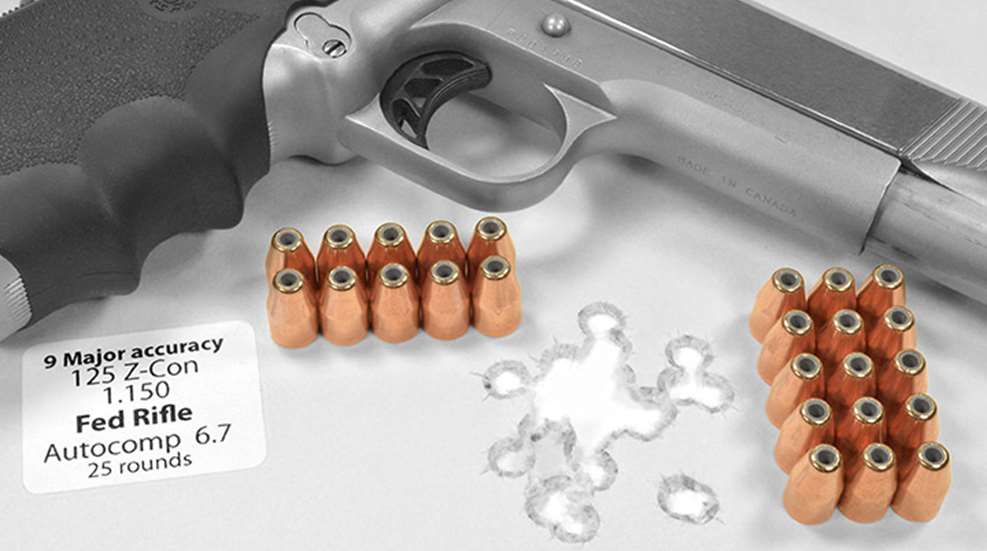
WARNING: All technical data in this publication, especially for handloading, reflect the limited experience of individuals using specific tools, products, equipment and components under specific conditions and circumstances not necessarily reported in the article and over which the National Rifle Association (NRA) has no control. The data has not otherwise been tested or verified by the NRA. The NRA, its agents, officers and employees accept no responsibility for the results obtained by persons using such data and disclaim all liability for any consequential injuries or damages.
In a previous article, I developed 9mm Major loads for a short 4.6-inch Lone Wolf (Alpha Wolf) barrel in a Glock G19. The accuracy results from the Glock were not great in large part to that Glock not being especially accurate—it won’t win any Bullseye matches. Some of the 10-shot groups were okay, and wondering what type of accuracy I would get with these loads pushing bullets at such high speed, I tested them in my 1911 with a 5-inch Kart barrel that’s known to shoot well.
I used the same powders, charge weights, case brand (once fired Blazer 9mm) and primers (Federal small rifle) as in the first article. I used the same 115-grain Hornady HAP bullets for this accuracy test, but used a different 125-grain JHP bullet.
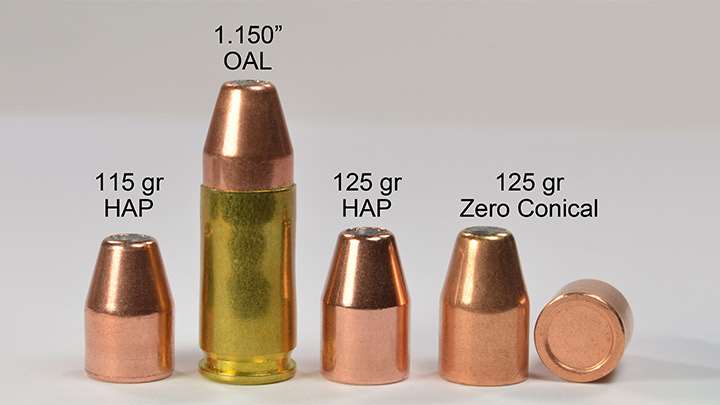
For the Lone Wolf barrel in the Glock, I used Hornady 115- and 125-grain HAP bullets loaded to 1.150-inch overall length. My Kart barrel has slightly different throat dimensions. It would accept the Hornady 115 HAP bullets at 1.150 inch, but it would not accept the 125-grain HAP bullets at that length. The 125-grain HAPs would have to be loaded to a shorter 1.130-inch overall length in order to fit the Kart. The 115-grain HAP bullets measure 0.355 inch in diameter and the 125-grain HAP measures 0.356-inch. Presumably that extra 0.001 inch diameter or subtle differences in the nose shape make a big difference for the Kart barrel.
Loading bullets deeper with the same powder charge increases pressure. When working at such high pressure in 9 Major ammunition, you want to keep the pressure as low as possible because with most loads they are already well past SAAMI pressure limits for the 9mm cartridge. Thus, there is a big advantage to loading them as long as possible to keep pressure low. Ideally, I wanted to keep the same overall length so I could use the same powder charges as I used in the first article. In order to use the 125 HAPs seated deeper, I would have to reduce the powder charge to keep peak chamber pressure in the same range as the long loaded bullets.
My solution was to use a different 125-grain bullet. Zero makes a 125-grain jacketed bullet that looks just like the Hornady HAP. Zero’s conical-nosed jacketed bullet is a near twin of the Hornady bullet, and I can seat the Zero bullet to 1.150-inch OAL and still fit the Kart’s chamber. The Zero bullet is slightly longer (0.008 inch) than the Hornady, which means if they are loaded to the same overall length, the Zero bullet would be deeper in the case which would raise pressure. However, the Zero bullet has a short “hollow” base. I did some measurements of the hollow base and some quick geometry for volume and was satisfied that the Zero bullet loaded to 1.150 inch would occupy roughly the same case volume as the Hornady bullet at 1.150 inch, and so should not dramatically change pressure. I have not experienced any issues when using these two bullets interchangeably in my pistols.
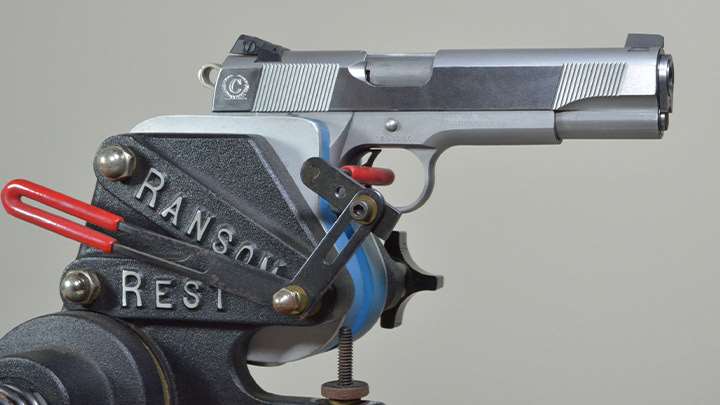
The 10 shots I used for the first article is a relatively small sample size, and since this article focused on accuracy, I loaded 25 rounds of each load for this test. I fired all 25 rounds into a single group, which I feel is a better measure of how consistently a gun shoots a load than shooting multiple groups. The gun was fired from a Ransom Rest to eliminate human-induced errors that could affect group size.
The gun was a hybrid 1911-type pistol with a Para Ordnance wide body frame, a Caspian slide and a 5-inch ramped Kart XACT FIT barrel. It’s not a match-grade pistol by any means. The barrel fits the slide well but there is some slop in the slide to frame fit.
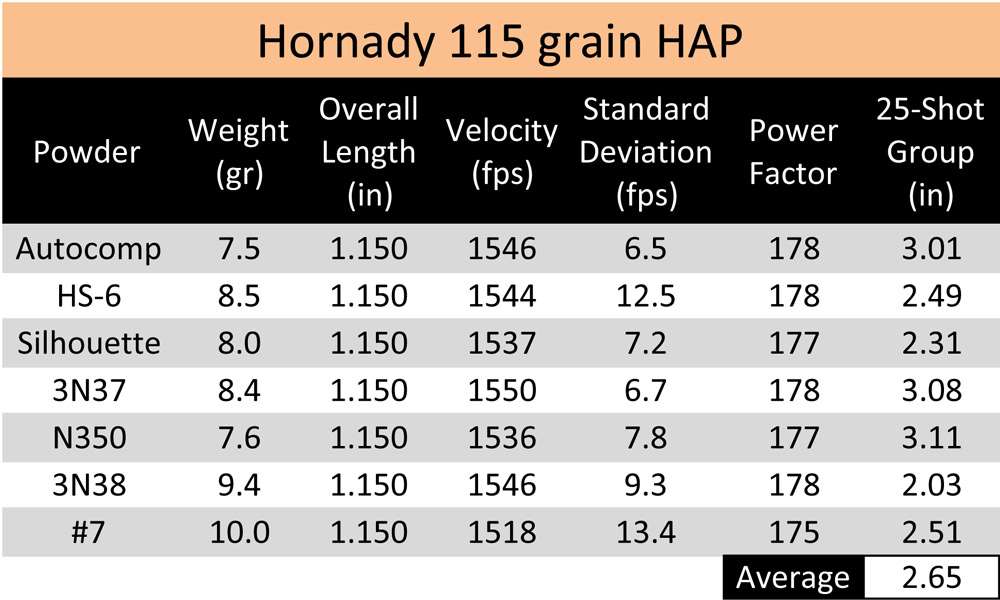
Velocities from the 5-inch Kart barrel were a little higher than what the 4.6-inch Lone Wolf barrel produced. This was expected because the Kart barrel is a little longer. Average power factors ranged from a low of 171 to a high of 180, high enough to easily meet a minimum 165 power factor required for Open division in IPSC/USPSA matches.
The results showed that even really fast, extremely high pressure 9mm Major loads can be very accurate at 25 yards. The 115-grain HAP bullets had an average 25-shot group size of 2.65 inches from the Kart barrel. The smallest group was with 3N38 and measured 2.03 inches, and the largest group was with N350 and measured 3.11 inches. That’s not much difference in size between the smallest and largest groups, and even a three-inch group size is quite good for 25 shots for this pistol. Four of the powders produced 25-shot groups that were at, or under 2.5 inches: HS-6, Silhouette, 3N38 and Accurate #7.
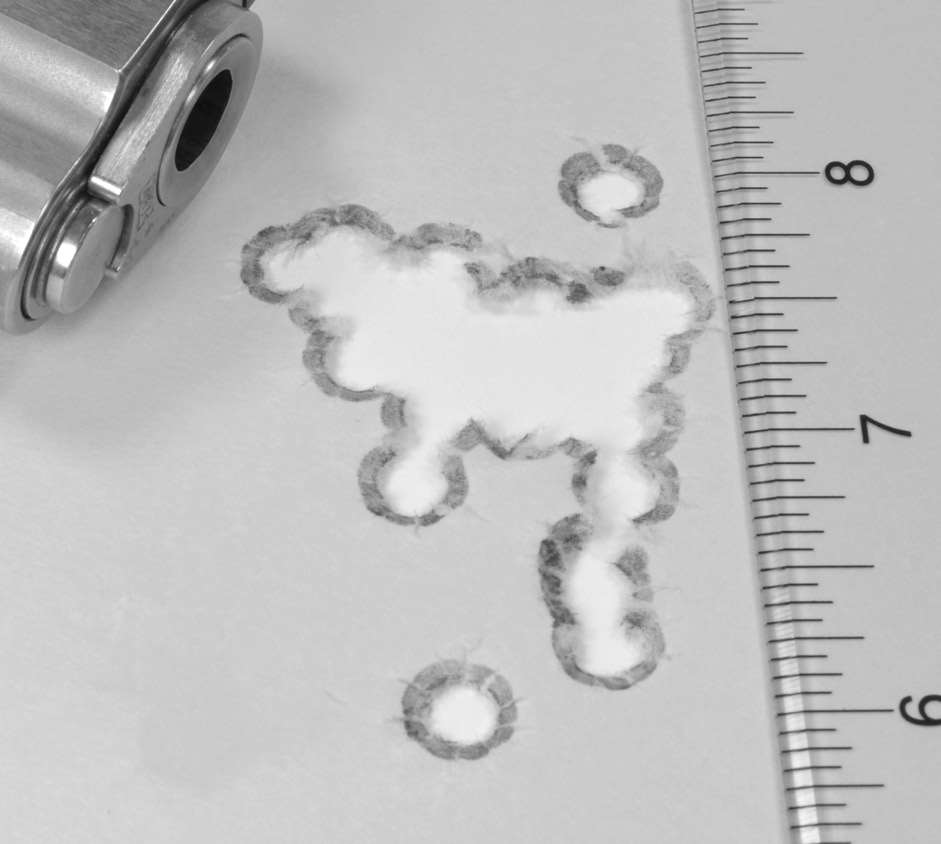
The results with the 125-grain Zero JHP were better. The average 25-shot group size was 2.02 inches. The smallest group was with HS-6 at 1.56 inches, and the largest group was 2.58 inches with 3N37. The difference in size between the smallest and largest groups was just one inch, roughly the same as the 115-grain bullets. Three of the powders produced 25-shot groups that were under 2.00 inches: Autocomp, HS-6 and 3N38.
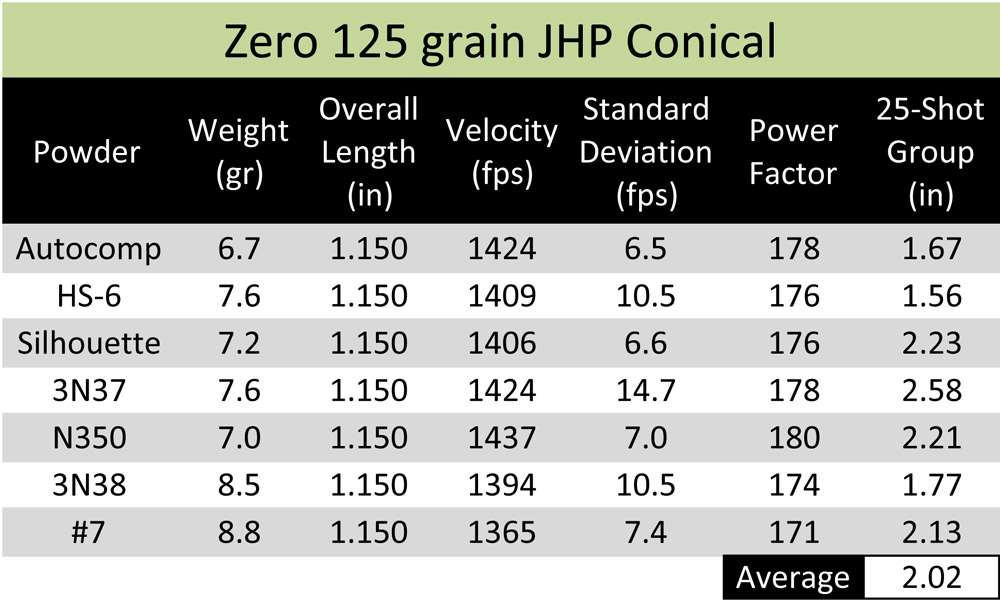
The final table shows the size of the 10-shot groups with the 4.6-inch Lone Wolf barrel in the Glock from the previous article and the 25-shot groups from the Kart barrel. There’s no obvious correlation between the accuracy of a given powder in both barrels. The Lone Wolf barrel did produce the smallest groups with 115- and 125-grain bullets with 3N37, but keep in mind that that test was only 10 shots, and a more stringent test would require more than 10 rounds, and the Lone Wolf results could change. Loads with 3N37 in the Kart barrel were some of the largest.
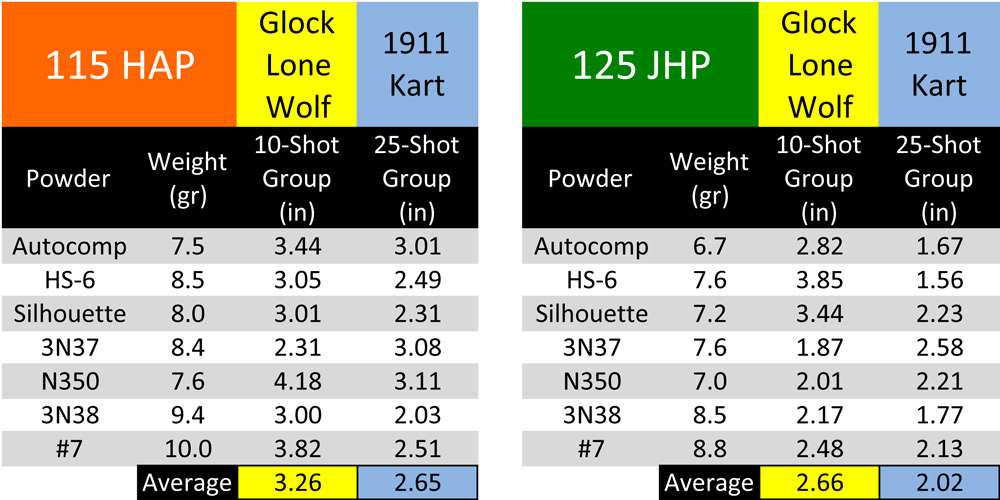
The Kart barreled 1911 did produce smaller groups with most loads than the Lone Wolf-barreled Glock. And given that the Glock testing only used a single 10-shot group, more rounds would likely have increased group size. Both guns/barrels appeared to prefer the 125-grain bullets overall, as their average group size was smaller than the 115-grain bullets.
Powder choice can affect performance in a compensated pistol. Compensators deflect gas to reduce recoil and muzzle rise. More gunpowder weight means more gas pressure—powders that require more charge weight to push the same bullet to the same speed reduce muzzle rise more. That said, some of the powders feel different, and this can be influenced by how many chambers and/or popple holes the gun has.
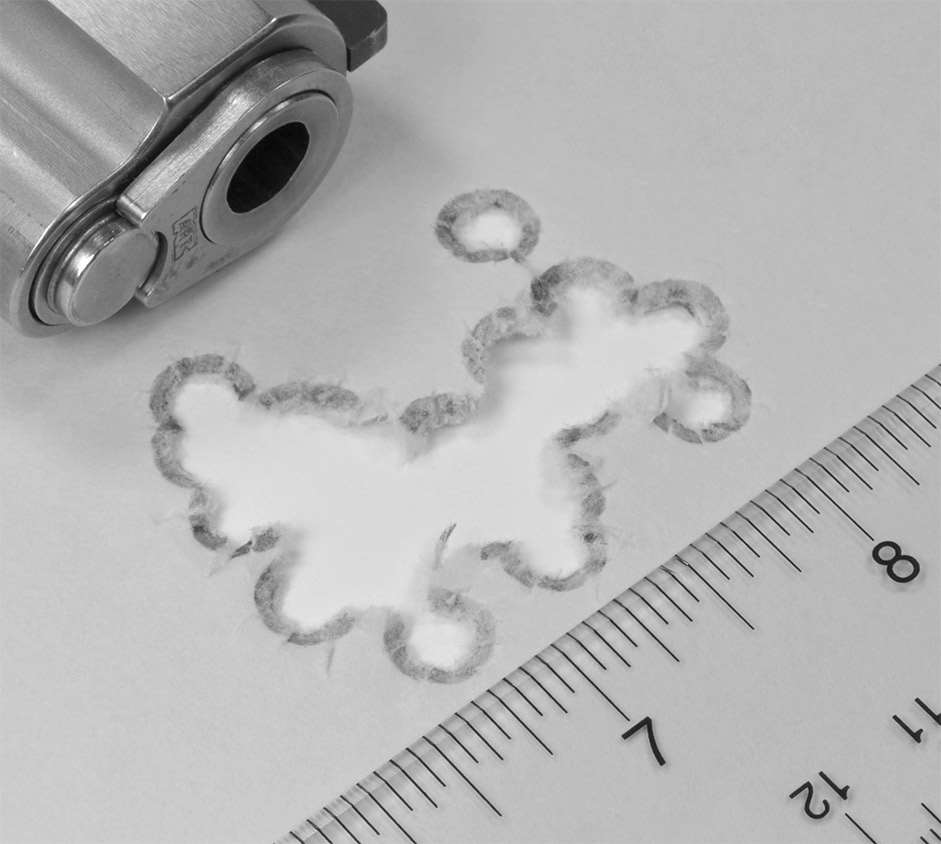
This accuracy test shows that 9 Major ammunition can be very accurate and consistently accurate as reflected by firing all 25 shots in one group. Also demonstrated is the fact that a gun might shoot several loads accurately, giving the handloader several options for finding the right load for their gun. Every gun/barrel is different and shooters have to try different loads to learn what their gun likes best. Readers who might use this data for load development must start with reduced charges and work up slowly with a chronograph to monitor power factor and watch for signs of excess pressure.
Warning: 9 Major is a 9mm Luger case loaded with more powder in order to make the required power factor to be eligible for Major power factor scoring in Open division of IPSC and USPSA sanctioned matches. This ammunition requires a gun specifically built for this competition with a barrel designed to handle extreme pressures of 9 Major ammunition. This ammunition should never be used in a gun not specifically designed for it. Check with your gunsmith to make sure your gun meets the necessary criteria. Use of 9 Major loads in guns not specifically designed for this cartridge can result in a very dangerous condition that can lead to damage to the firearm and injury or death to the shooter and bystanders.
See more: 5 Great Action Pistols Under $700














